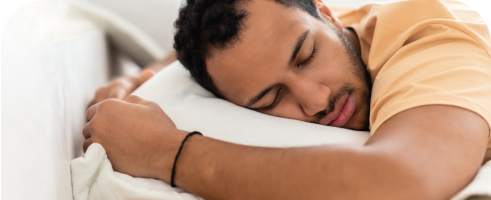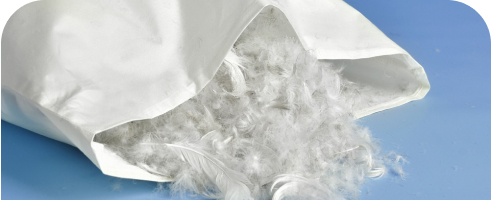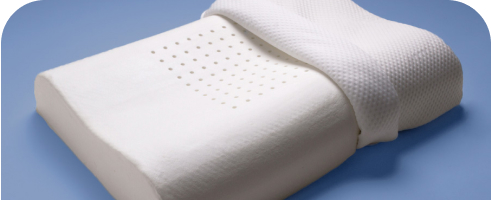How to Wash Pillows
Pillows should be cleaned regularly to help prevent the buildup of bacteria and odors. Special care is required when cleaning or washing pillows to prevent damaging the fill. Memory foam can break down when not cleaned correctly, and materials in other pillows can clump or shrink if they aren’t properly handled. We’ll cover what you need to know before washing your pillows.
Find a Pillow That’s Right for You
Looking for a new pillow? Take the quiz below to find the perfect pillow for your needs.
Trouble sleeping?
Answer these 5 easy questions to discover your perfect pillow

Trouble sleeping?
Answer these 5 easy questions to discover your perfect pillow
What position do you sleep in?

Side

Back

Stomach
How to Wash Pillows
Many pillows are safe to machine wash, but some require specific care. The first step in proper pillow care is checking the tag for cleaning tips.
We’ll highlight a few of the suggestions you may find on your pillow tags and what to keep in mind:
- Dry Clean Only: These pillows should be taken to a professional dry cleaner, and should not be washed. Submerging them in water may damage the fill or cover. The tag may also say “Do not wash.”
- Spot Clean Only: Clean spots and stains on the surface, rather than washing the entire pillow.
- Hand Wash: The pillow can be gently washed by hand. This generally means it can be submerged in water, but the spin cycle of the washing machine may damage the pillow.
- Machine-Washable: Pillows that are machine-washable will typically include care instructions on the tag. These may include machine washing the pillow on the delicate cycle, or avoiding bleach or harsh detergents.
Once you determine whether or not it’s safe to machine wash your pillows, consider washing them in pairs to balance out the weight, as they will become quite heavy with water. The majority of pillows can be washed using warm water, a gentle cycle, and a small amount of mild detergent. That said, proper care will often depend on the materials used to construct the pillow.
It can take a while for any pillow to fully dry. When tumble drying the pillows, additional time may be needed to dry the interior fill, even if the cover feels dry. Adding clean dryer balls or dry towels to the dryer can help expedite the process.
Not all pillows should be tumble dried. Some can be dried outside in the sun or in a well-ventilated spot. It’s important to allow your pillow to dry fully before using it.
How to Wash Feather or Down Pillows
Feather and down pillows require special attention to protect the loft and integrity of the fill. Always follow the manufacturer’s specific guidelines, as many feather and down pillows can only be dry cleaned. If the pillow can be washed, it should be done carefully:
- Choose a soap designed for feathers or down, or a mild detergent.
- Use only a small amount of soap to prevent clumping or residue.
- Use cool or warm water, as hot water can damage feathers and down.
- Choose delicate settings in order to keep the materials inside from clumping.
- Add another rinse cycle to remove any remaining soap residue.
- Add another spin cycle to get rid of excess water.
- When using a dryer, use the lowest heat options over multiple cycles.
- Fluff your pillows between cycles to break up any clumps.
When drying, you can gently squeeze water out of the pillow, but do not wring it out. Consider using dryer balls to keep pillows fluffed while drying. You can also wash these pillows carefully by hand in a solution of detergent and water.
How to Wash Memory Foam Pillows
Solid memory foam pillows should not be machine washed, as this can cause the foam to crack or degrade. They also should not be submerged in water. These pillows can be spot cleaned as needed to remove stains or residue. Lingering odors can often be removed by sprinkling the pillow with baking soda, allowing it to sit, and then vacuuming it.
Shredded memory foam pillows can often be washed, but it’s important to check any instructions provided by the manufacturer. In the event the memory foam pillow can be hand washed, special care should still be taken:
- Use a sink or bathtub to create a solution of room temperature water and mild detergent.
- Put your memory foam pillow in the solution. Squeeze water in and out of the pillow.
- Drain the solution from the sink or bathtub. Refill with lukewarm water.
- Squeeze the pillow to replace any remaining solution with clean water.
- Keep squeezing the pillow carefully until the water coming out of your pillow is clear.
- Squeeze any remaining water out of the pillow and leave to air dry in direct sunlight.
- To help expedite the drying process, you can place the pillow in front of an electric fan.
How to Wash Throw Pillows, Body Pillows, and Other Specialty Styles
Throw pillows should be washed once every 3 to 6 months, depending on how frequently they are used. Most throw pillows can be cleaned with the following guidelines:
- Remove the cover if possible, and wash it separately from the pillow itself.
- Use lukewarm water and a gentle cycle for throw pillow covers.
- Use warmer water temperatures and a delicate cycle for the inner pillows.
- Dry on low or medium heat on a low tumble setting, if possible.
- If the pillow is made with fragile materials, hand wash it in warm water and air dry.
When it comes to body pillows, neck pillows, and other pillow types, you should first consult the pillow tag for any special cleaning instructions. This is also where you’ll find out what type of fill is being used, allowing you to determine which instructions to follow. Many pillows have removable covers that can be machine washed as needed.
How Often Should Pillows Be Washed?
Most pillows should be washed at least twice a year, but some may require more frequent care. Over time, your pillows can trap dirt, sweat, oil, and even fungus. If left unwashed, these problems can lead to odors and health concerns.
Cleaning your pillows is the best way to make sure they last as long as possible, but eventually even the most well-maintained pillow needs to be replaced. We usually recommend replacing your pillows every 1 to 2 years, but the best pillows can last up to 5 years with proper care.

Still have questions? Ask our community!
Join our Sleep Care Community — a trusted hub of sleep health professionals, product specialists, and people just like you. Whether you need expert sleep advice for your insomnia or you’re searching for the perfect mattress, we’ve got you covered. Get personalized guidance from the experts who know sleep best.
















































































